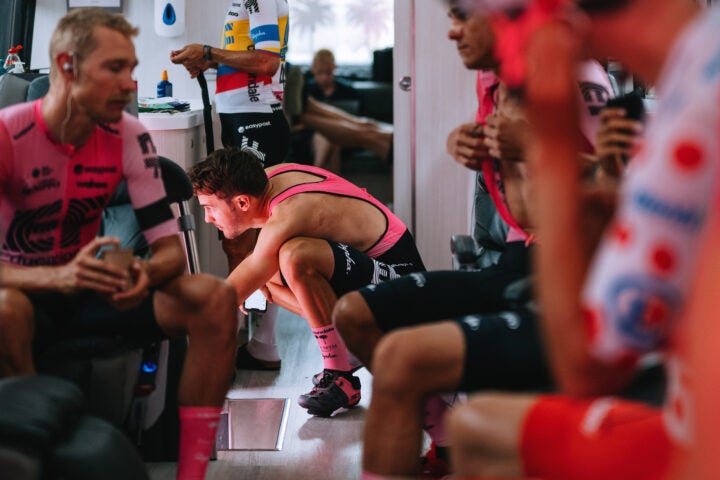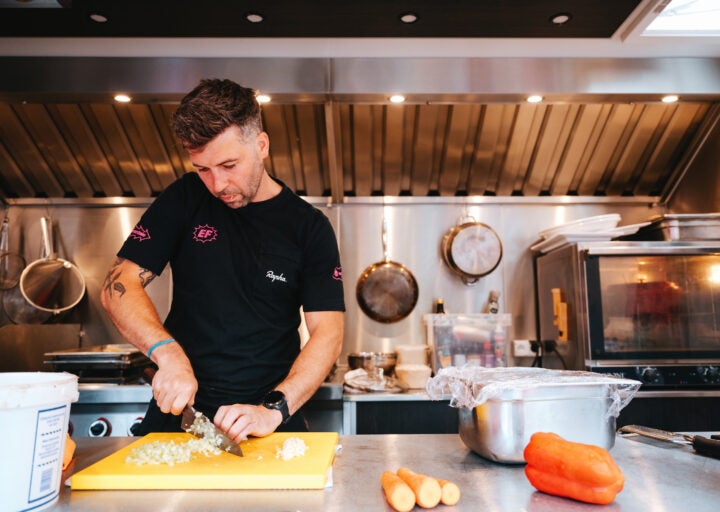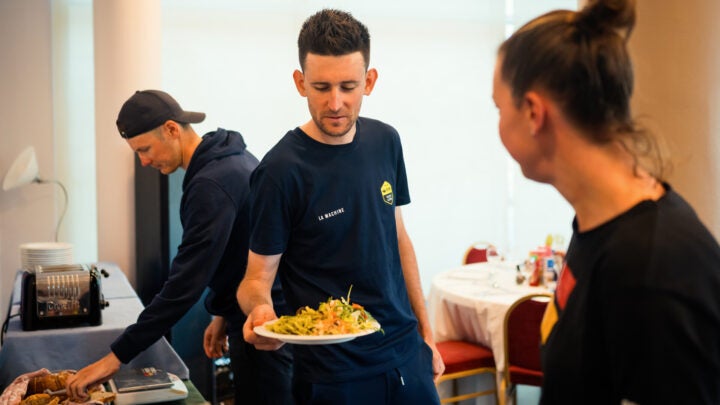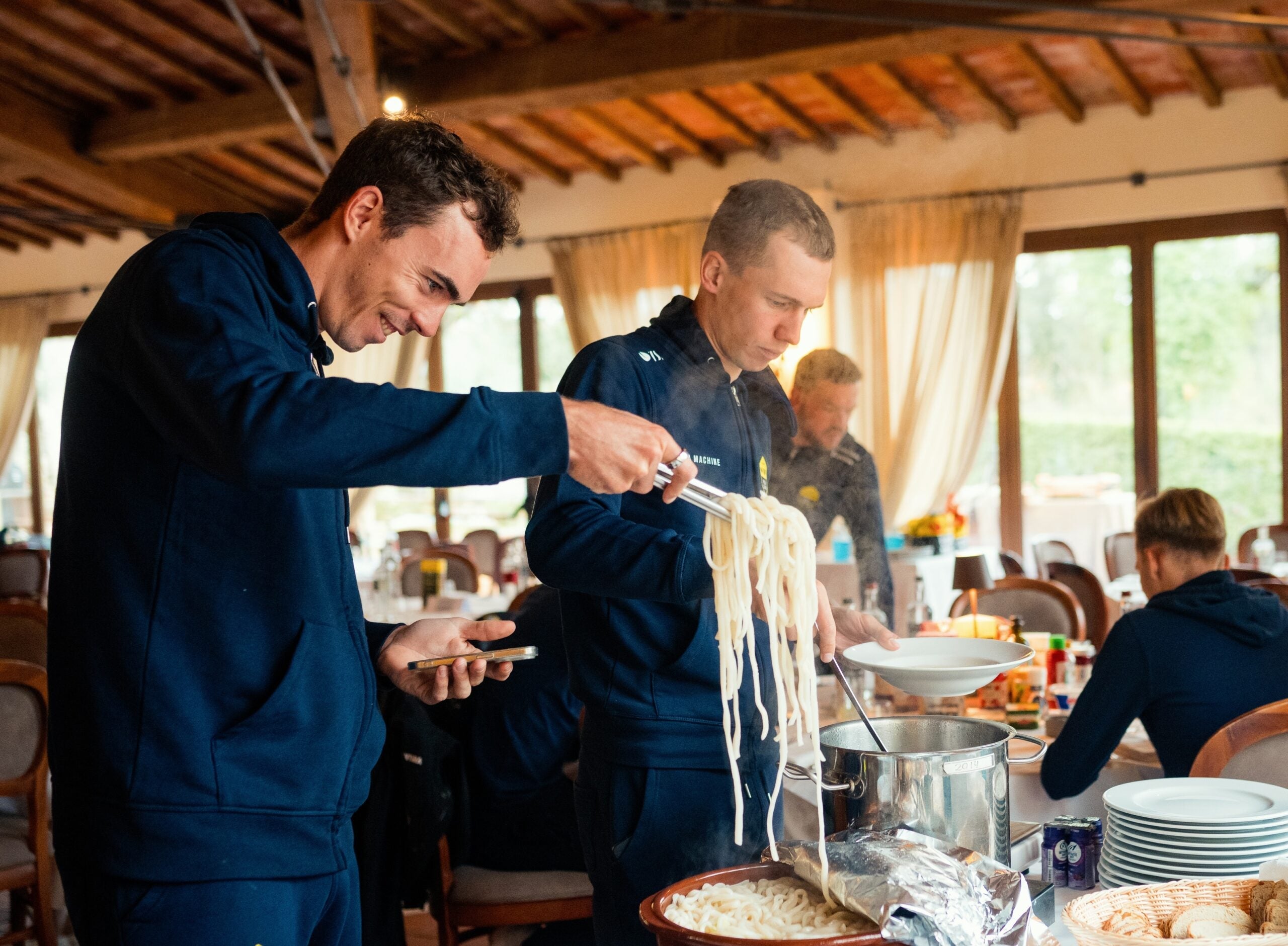The daily menu of a rider is a multi-course, 8,000-calorie gut-buster cooked up by science and flavored like carbs.
From early morning rice binges to late-night pasta parties, , , and the Tour de France peloton get little respite from meal plans that are interrogated to the macronutrient and managed to the micro level.
In a sport that’s reduced to the finest margins, nutrition has become as essential as VO2 max, aerodynamics, and race craft. are just as much a part of the Tour de France entourage as mechanic stations and massage tables.
The pressure to achieve perfect fueling means a Tour de France daily menu is as complex as a six-month training schedule or a mechanic’s Di2 manual. They’re the product of nutritionists and physiologists as much as a team’s own Michelin-level chef.
Here’s how a day on Tour might taste:
T-minus Three Hours to Stage: A Breakfast that Looks like Dinner

The breakfast buffet:
- For the new-school: Rice, pasta, noodles, quinoa, eggs, fruits, juices/smoothies, electrolyte and prebiotic drinks, coffee.
- For the traditionalist: Oatmeal, cereals, bread, pancakes, eggs, cold meats, yogurts, fruits, juices/smoothies, electrolyte and prebiotic drinks, coffee.
A rider could burn more than 5,000 calories during the hardest stages of the Tour de France.
That enormous energy demand means the gruppetto awaits anyone who missed a few mouthfuls that morning.
Resultantly, breakfast is a multi-course banquet devoted to the church of carbohydrates.
“In general, most riders will have four times their body weight in grams of carbohydrates at breakfast alone,” Israel Premier Tech nutritionist Gabriel Martins said.
“I dare a normal person to try to eat this amount of food at breakfast,” he said. “Most of us would struggle to do that in a whole day.”
The peloton is divided into two echelons of breakfast preferences.
For some, “breakfast” is a morning meal that looks and tastes like dinner. Bulging bowls of rice, pasta, noodles, and quinoa provide an easy energy fix.
For the diminishing resistance that maintains 9 am is no time for rice, oatmeal, breads, and pancakes are the centerpiece of a “traditional” tasting morning meal.
“Rice is now the preference carbohydrate for us, and we encourage it for our riders. It’s perfect race food. It’s super carbohydrate dense, gluten-free and so it is easy to digest,” JAyco-AlUla nutrition scientist Laura Martinelli told Velo. “We encourage it for any, or all, the meals of the day.”
Whatever a rider’s preference, breakfast serves as the final phase of a 24/7 “carb load” that ensures grand tour riders are ready to race for three weeks straight.
Most riders in the Tour peloton will aim to chow 10-12 grams of carbohydrate per kilo of body mass in the 24 hours before any stage that’s expected to be a sufferfest.
For ~60kg Jonas Vingegaard, that’s a 600-720g “carb load”, the equivalent of approximately 2,500 calories. In real terms, that’s a gut-wobbling three kilos of cooked white rice.
There is some respite from all things starch and sugar.
Nutrition-packed smoothies and small serves of muscle-saving protein accompany the carbohydrates and provide a welcome break from bowls of beige.
“We have to make sure food remains interesting to riders, especially on a grand tour when they eat so much every day,” Martinelli said. “The colors and flavors, even the textures, need to be varied and bright. Otherwise riders get ‘bored’.”
T-minus 30 Minutes to Stage Start: A Caffeine Boost and a Sugar Rush

The tank-topper:
- Rice cakes, wraps, energy bars.
- Espresso, espresso, espresso!
Just a few short hours and a bus ride after breakfast, it’s time to eat again.
Riders slam several espressos and chew on energy bars, bananas, and rice cakes while they pin numbers and ratchet shoes in buses that serve as kitchens, bathrooms, and lounges.
Those final espressos aren’t just a token nod to cycling tradition.
Caffeine is one of the few legal ergogenic aids. A dose of 3-6mg/kg body mass is proven to boost endurance, enhance cognition, and benefit perceived exertion.
Every rider will have established their caffeine limit during training and will buzz their way toward that threshold at breakfast, on the bus, and finally on the bike with a pocket full of rocket-fuel caffeine gels.
During the Stage: The Carb Frenzy

In the bottles, musettes, and jersey pockets:
- Energy gels, chews, bars.
- Carbohydrate and electrolyte drinks.
- Rice cakes, wraps, mini cokes.
Aero bike frames, electronic gearsets, and have made the Tour de France a totally different sport from that of even a decade ago.
In-race fueling strategies progressed just as fast.
This decade has seen a that shifted the dial on what’s possible for performance.
Energy gels and drinks pack improved carbohydrate ratios and hydrogel technologies that allow riders to take down sugars at unprecedented rates.
“Carbohydrate targets during racing increase year by year” Jayco-AlUla’s Martinelli said. “I started working in cycling in 2013, and at that time, 70-80 grams of carb per hour was the ideal target to be competitive. Nowadays, you need 100-110g at least.”
The rise of gut- and pallete-friendly gels and drinks has driven the pace of the pro peloton.
Riders can push thresholds higher in training and recover faster from their efforts to achieve an upward spiral of progress.
They can be more aggressive in racing, for longer periods.
The era of gut-rotting GI distress and race-ending “bonks” is long gone.
“The ability to tolerate carbs is becoming one of the biggest factors in winning or losing,” Astana-Qazaqstan trainer Vasilis Anastopoulos said.
Most riders now rely almost purely on energy products to power a day in the saddle.
Gels and bars are easy to eat, carb-dense, and pocket-friendly. Energy-packed drinks can meet fueling and hydration needs with a few thirst-quenching sips.
A rider aiming at the new “gold standard” of 120 grams per hour of carbohydrate might be slurping three or more energy gels per hour for a constant flow of fast fuel that guarantees they’ll never be hit by “the hammer.”
The musette picnic of rice cakes, wraps, and cokes so central to the Chris Froome era are now just a decorative cherry on top of the synthetically produced cake.
“’Normal foods’ go into the race bags as much to help a rider’s morale as anything,” Lidl-Trek nutritionist Stephanie Scheirlynck told Velo. “There’s not much performance benefit, but they do no harm and keep riders happy, so why not?”
At the Finish Line: A Recovery Kick-starter of Ketones, Carbs, Sodium

Drinks from the bar:
- Water, sodas, juices, ketone mixes, hydration mixes.
- Haribos!
Riders are met at the finish line of the Tour de France by a stocked bar of recovery-boosting drinks.
Staffers laden with bottles of water, soda, and ketone mixes hustle out to riders and thrust drinks their way before they’ve barely caught breath. Bags of candies serve as the finish line finger-food.
“Riders now mostly get a juice after races. The main thing is to provide them with simple sugars; glucose and fructose to start replenishing the glycogen stores,” Bora-Hansgrohe nutritionist Tim Podlogar told Velo.
“Sometimes the juice is cherry juice as there is some evidence that this can help with recovery,” he said. “Then, they usually get some gummies or dates. Again, it’s simple sugars.”
Ketones, the peloton’s , are also a part of the mix.
This so-called “fourth macronutrient” rose to the headlines off the back of its perceived impact on performance, but the peloton now chooses ketones primarily for recovery.
“Ketones help recovery and lower chronic inflammation and oxidative stress,” Alpecin-Decuninck team doctor Peter Lagrou said. “Both are very important in the prevention of illness, injuries, overuse, mental and cognitive fatigue.”
One Hour Post-Stage: A Bus Ride Buffet for Rapid Replenishment

The post-ride picnic:
- Protein shake: Whey, optional aminos, and maltodextrin (sugar).
- Carbs: Rice, pasta, potatoes.
- Lean proteins: Chicken, fish, eggs.
The team bus provides riders sanctuary from the melee of bike-mad crowds and pesky media crews.
Nowhere is safe from the full-time requirement to fuel, however.
“It’s crucial the guys eat on the bus,” Lidl-Trek expert Scheirlynck said. “Dinner won’t be for many hours, and the faster they can start to reload their energy, the better it is for recovery. It simply can’t be missed in a three-week race.”
A pre-shower smoothie ensures riders hit the benchmark 20 grams of protein required for rapid muscle synthesis before an on-board meal continues the replenishment process.
Intriguingly, protein is less a priority in a than the shelves full of protein shakes, snacks, and supplements at your local health store may have you believe.
Protein isn’t the priority for an endurance athlete who burns days’ worth of energy in a few breathless hours of WorldTour racing.
“We have to prioritize carbohydrate in the hours after the stage, so we keep protein intake to about 30-40 grams in total,” Israel Premier Tech nutritionist Vanessa Zoras said. “We then aim for riders to consume at least 2-2.5 grams per kilogram over the rest of the meals and snacks throughout the day.”
A shake and a a shower later, it’s finally time for “real” food.
“Each rider will get a fresh pre-packed meal on the bus that was prepared by our chef, or there will be dishes on board,” Martinelli said. “It’s usually rice, pasta, or potatoes, with a protein accompaniment like chicken or tuna.
“We also make sure it’s colorful with vegetables, and make sure it’s pleasing to eat,” she said. “It can be hard for riders to ‘force’ food in after these races, so the meal has to look and taste good.”
This post-race meal isn’t the type of go-til-you-blow affair that rewards an amateur warrior after their big weekend ride.
Nutritionists like Martinelli and Scheirlynck extrapolate “workload” scores from power meters into portion sizes and protein-carb-fat ratios that perfectly offset a rider’s exertions of the day.
“We calculate riders’ recovery targets rather than leave them to go by ‘feel’ or hunger cues,” Jayco-AlUla’s Martinelli said, referring to the re-feeding process. “When a rider is very tired, and their appetites are suppressed, they could very easily get it wrong.”
Four (ish) Hours Post-stage: A Dinner Tailored to the Next Day

A dinner for the next day:
- Pre-mountain stage menu: A calorie-dense meal focused on carbohydrate, with minimal vegetables and lean protein: Rice, pasta, potatoes, chicken, fish.
- Pre-sprint stage menu: A high-volume, lower calorie meal rich in nutrients, lower on carbohydrates: Salads, soups, pulses, grilled or steamed vegetables, quinoa chicken, fish … and of course, rice, pasta, potatoes.
- Pre-rest day menu: Home-made burgers, pizza, lasagne, barbecues.
The evening meal is designed with both recovery and refueling in mind.
Like how the post-ride meal reflects the demands of that day’s stage, the evening meal reflects what’s to come.
When a climbing stage that might burn 5-6,000 calories is on the horizon, riders eat a suitably mountainous meal focused on energy-rich carbohydrates.
Vegetables, salads, and proteins make only a small proportion of a meal designed to take riders toward the crushing carbohydrate benchmarks set on the Tour’s hardest days.
The script is flipped the evening before an “easy” sprint stage.
“When we think of grand tour menus, it’s about ‘function’ for the mountains, and ‘health’ the rest of the time,” Scheirlynck said.
“But we think about satiety, too. On a mountain stage we try to create a small volume of food that’s packed with energy,” she said. “Conversely, before a sprint stage, we look to proteins, big salads, and soups to help make riders feel full without overloading on calories.”
Team chefs even consider the weather when concocting their multi-course menus.
Riders will be met with cold soups and iced deserts after a scorcher on the Côte d’Azur, but hearty broths and warming stews after a rain-soaked stage up in Brittany.
Nutritionists pull at the three levers of nutrition – carbohydrates, proteins, and fats – when they design every meal.
Fiber is another variable that’s carefully fine-tuned.
Fibrous vegetables and salads are scrapped the evening before a mountain stage in that prevents riders from retaining water and gaining weight.
A pre-mountain day dinner is a dreary affair of beige “fuel” rather than an Instagram-worthy rainbow plate of health-supporting nutrients and vitamins.
The “good stuff” a rider’s mom would have them eat – multi-color vegetables, healthy fats, and pulses – is reserved for other evenings.
“We look at nutrition across the grand tour as a whole and balance it across that whole period,” Lidl-Trek expert Scheirlynck said.
“The meals on some days may seem plain, maybe unbalanced. But across the three weeks, we ensure riders get everything they need in terms of vitamins and minerals.”
And the evening before a rest day or perhaps the night of a team victory?
There’s no trip to the nearest “Golden Arches” or pizza joint. Fatty patties and pepperoni parties have to wait for when riders start fueling for stage 22.
Instead, team chefs serve their own take on a Tour de France “cheat meal”.
Homemade burgers, tacos, and lasagnes using lower-fat, higher-nutrition recipes feel like a celebration but don’t overdo the calories. Some teams serve up some bubbly, while others maintain policies to abstain.
Just a few episodes of Netflix and a 10-hour sleep later, and the fueling frenzy starts all over again.


